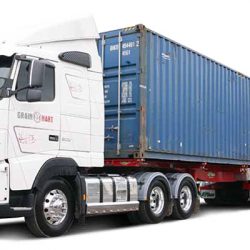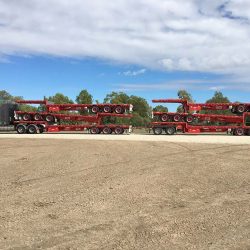This is the first in our four-part series on Performance Based Standards, to which the Drake Group adheres. Read on to find out all about the importance of Performance-Based Standards, approval processes, vehicle standards, guidelines, and rules for trailer manufacturers.
The National Heavy Vehicle Regulator (NHVR) introduced the Performance-Based Standards (PBS) scheme in October 2007. The PBS scheme aims to improve the productivity and safety of heavy vehicles. All PBS vehicles must meet 16 standards – eight for safety and four for infrastructure. Collectively, these standards measure the vehicle’s appropriateness for its job and location.
While it’s commonplace now throughout the heavy transport equipment and haulage industry, there was one trailer manufacturer in Brisbane who adopted these standards long before their competitors. O’Phee Trailers (now part of The Drake Group) saw the need for increased efficiency and new areas of growth. For Mick O’Phee, it was important to embrace the philosophy as an overall business strategy.
“We created a comprehensive infrastructure around the general PBS scheme, from sales consulting right through to approval management. It was an important lesson at the time and is still true today: If you can’t translate inherent complexity into a stress-free experience for the client, you will fail.”
PBS standards for safety
The first four standards apply to the vehicle’s longitudinal performance at low speed. These are:
- Startability: Can the vehicle start moving from a stationary position on a particular grade?
- Gradeability: Can the vehicle continue moving along a particular grade? Can the vehicle move at a low speed on a 1% grade?
- Acceleration capability: Can the vehicle accelerate from either a stationary position or while moving on a road?
- Tracking ability on a straight path: When the vehicle is moving along a straight path, what is its total swept width?
Another eight PBS standards apply to the vehicle’s directional performance at low speed. These are:
- Swept path at low speed: When the vehicle turns 90 degrees at low speed, how wide is the swept path at its widest?
- Frontal swing: What is the biggest lateral outswing of the vehicle’s front outside corner?
- Tail swing: What is the biggest lateral outswing of the vehicles outside back corner?
- Steer tyre friction demand: When the vehicle performs a turn at low speed, what is the highest friction of the steer tyre?
- Static rollover threshold: When turning, what level of steady lateral acceleration can the vehicle achieve, without tipping?
- Rearward amplification: What the vehicle changes lanes, what is the extent of the “whip crack” effect?
- High-speed transient offtracking: When the vehicle moves suddenly, how far does the rear axle overshoot?
- Yaw damping coefficient: When the vehicle moves suddenly, how long does the rear trailer take to recover?
PBS standards for infrastructure
There are four standards for infrastructure, as follows:
- Pavement vertical loading: How much vertical pressure does the vehicle apply to the pavement?
- Pavement horizontal loading: How much horizontal pressure does the vehicle apply to the pavement?
- Tyre contact area: To what extent is tyre pressure spread evenly over the pavement?
- Bride loading: What is the vehicle’s highest impact on a bridge, when compared with another vehicle?
This marks the end of the first part in our four-part series on Performance-Based Standards. Keep an eye out of over the coming days for the next part in our series.



